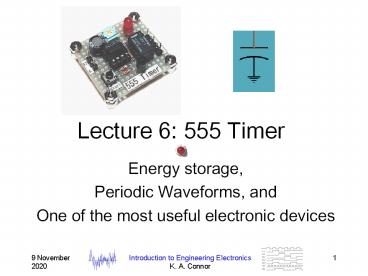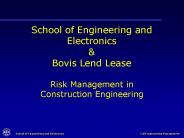Introduction to Engineering Electronics - PowerPoint PPT Presentation
Title:
Introduction to Engineering Electronics
Description:
One of the most useful electronic devices. 6/15/09. Introduction to Engineering Electronics ... Introduction to Engineering Electronics. K. A. Connor. 5 ... – PowerPoint PPT presentation
Number of Views:224
Avg rating:3.0/5.0
Title: Introduction to Engineering Electronics
1
Lecture 6 555 Timer
- Energy storage,
- Periodic Waveforms, and
- One of the most useful electronic devices
2
Examples of Physical Periodic Motion
- Pendulum
- Bouncing ball
- Vibrating string (stringed instrument)
- Circular motion (wheel)
- Cantilever beam (tuning fork)
3
Other Periodic Phenomena
- Daily cycle of solar energy
- Annual cycle of solar energy
- Daily temperature cycle
- Annual temperature cycle
- Monthly bank balance cycle
- Electronic clock pulse trains
- Line voltage and current
4
Daily Average TemperatureAlbany-Troy-Schenectady
- Data (blue) covers 1995-2002
- Note the sinusoid (pink) fit to the data
5
Using Matlab to Produce Audio Signal from Daily
Average Temps
- Data is normalized to mimic sound
- Data is filtered to find fundamental
6
Matlab Window
7
Periodic Pulse Train from a 555 Timer
- This circuit puts out a steady state train of
pulses whose timing is determined by the values
of R1, R2 and C1 - The formula has a small error as we will see
8
Using Models
- Recall that you should use a model that you
understand and/or know how to properly apply - To use it properly
- Check for plausibility of predicted values
(ballpark test). Are the values in a reasonable
range? - Check the rate of changes in the values (checking
derivative or slope of plot). - Are the most basic things satisfied?
- Conservation of energy, power, current, etc.
- Developing a qualitative understanding of
phenomena now will help later and with
simulations.
9
Charging a Capacitor
- Capacitor C1 is charged up by current flowing
through R1 - As the capacitor charges up, its voltage
increases and the current charging it decreases,
resulting in the charging rate shown
10
Charging a Capacitor
- Capacitor Current
- Capacitor Voltage
- Where the time constant
11
Charging a Capacitor
- Note that the voltage rises to a little above 6V
in 1ms.
12
Charging a Capacitor
- There is a good description of capacitor charging
and its use in 555 timer circuits at
http//www.uoguelph.ca/antoon/gadgets/555/555.htm
l
13
2 Minute QuizName___________
Section___True or False?
- If C1 lt C2, for a fixed charging current, it will
take longer to charge C1 than C2 - If R1 lt R2, for a fixed charging voltage, it will
take longer to charge a given capacitor C through
R1 than R2 - When a capacitor C is connected to a battery
through a resistor R, the charging current will
be a maximum at the moment the connection is made
and decays after that.
14
555 Timer
- At the beginning of the cycle, C1 is charged
through resistors R1 and R2. The charging time
constant is - The voltage reaches (2/3)Vcc in a time
15
555 Timer
- When the voltage on the capacitor reaches
(2/3)Vcc, a switch is closed at pin 7 and the
capacitor is discharged to (1/3)Vcc, at which
time the switch is opened and the cycle starts
over
16
555 Timer
- The capacitor voltage cycles back and forth
between (2/3)Vcc and (1/3)Vcc at times
and
17
555 Timer
- The frequency is then given by
- Note the error in the figure
18
Inside the 555
- Note the voltage divider inside the 555 made up
of 3 equal 5k resistors
19
555 Timer
- These figures are from the lab writeup
- Each pin has a name (function)
- Note the divider and other components inside
20
Astable and Monostable Multivibrators
- Astable puts out a continuous sequence of pulses
- Monostable puts out one pulse each time the
switch is connected
21
Astable and Monostable Multivibrators
- What are they good for?
- Astable clock, timing signal
- Monostable a clean pulse of the correct height
and duration for digital system
22
Optical Transmitter Circuit
Astable is used to produce carrier pulses at a
frequency we cannot hear (well above 20kHz)
23
Optical Receiver Circuit
- Receiver circuit for transmitter on previous
slide
24
Clapper Circuit
- Signal is detected by microphone
- Clap is amplified by 741 op-amp
- Ugly clap pulse triggers monostable to produce
clean digital pulse - Counter counts clean pulses to 2 and triggers
relay through the transistor
25
555 Timer Applications
- 40 LED bicycle light with 20 LEDs flashing
alternately at 4.7Hz
26
555 Timer Applications
- 555 timer is used to produce an oscillating
signal whose voltage output is increased by the
transformer to a dangerous level, producing
sparks. DO NOT DO THIS WITHOUT SUPERVISION
27
Tank Circuit A Classical Method Used to Produce
an Oscillating Signal
- A Tank Circuit is a combination of a capacitor
and an inductor - Each are energy storage devices
28
Tank Circuit How Does It Work?
- Charge capacitor to 10V. At this point, all of
the energy is in the capacitor. - Disconnect voltage source and connect capacitor
to inductor. - Charge flows as current through inductor until
capacitor voltage goes to zero. Current is then
maximum through the inductor and all of the
energy is in the inductor.
29
Tank Circuit
- The current in the inductor then recharges the
capacitor until the cycle repeats. - The energy oscillates between the capacitor and
the inductor. - Both the voltage and the current are sinusoidal.
30
Tank Circuit Voltage and Current
31
Tank Circuit
- There is a slight decay due to finite wire
resistance. - The frequency is given by
- (period is about 10ms)
32
Tank Circuit
- Tank circuits are the basis of most oscillators.
If such a combination is combined with an op-amp,
an oscillator that produces a pure tone will
result. - This combination can also be used to power an
electromagnet. - Charge a capacitor
- Connect the capacitor to an electromagnet
(inductor). A sinusoidal magnetic field will
result. - The magnetic field can produce a magnetic force
on magnetic materials and conductors.
33
Tank Circuit Application
- In lab 9 we will be using the circuit from a
disposable camera. - We can also use this type of camera as a power
source for an electromagnet.
34
Disposable Camera Flash Capacitor Connected to a
Small Electromagnet
35
Disposable Camera Flash Experiment/Project
- A piece of a paperclip is placed part way into
the electromagnet. - The camera capacitor is charged and then
triggered to discharge through the electromagnet
(coil). - The large magnetic field of the coil attracts the
paperclip to move inside of the coil. - The clip passes through the coil, coasting out
the other side at high speed when the current is
gone.
36
Coin Flipper and Can Crusher
- The can crusher device (not presently in
operation) crushes a soda can with a magnetic
field.
37
Can Crusher and Coin Flipper
- This is an animation a student made as a graphics
project a few years ago
38
Can Crusher and Coin Flipper
- For both the can crusher and coin flipper, the
coil fed by the capacitor acts as the primary of
a transformer. - The can or the coin acts as the secondary.
- A large current in the primary coil produces an
even larger current in the can or coin (larger by
the ratio of the turns in the primary coil) - The current in the coin or can is such that an
electromagnet of the opposite polarity is formed
(Lenz Law) producing two magnets in close
proximity with similar poles facing one another. - The similar poles dramatically repel one another
39
Magnetic Launchers
- Coilguns/Railguns
40
Coilguns Railguns
- Two types of launchers are being developed for a
variety of purposes.
41
Where Will You See This Material Again?
- Electromagnetic Fields and Forces Fields and
Waves I - 555 Timers Many courses including Analog
Electronics and Digital Electronics - Oscillators Analog electronics
- Clocks, etc Digital Electronics, Computer
Components and Operations, and about half of the
ECSE courses.
42
Appendix
43
Using Conservation Laws to Derive Fundamental
Equations
- Energy stored in capacitor plus inductor
- Total energy must be constant, thus
44
Using Conservation Laws
- Simplifying
- This expression will hold if
- Noting that
45
Using Conservation Laws
I
VL
VC
- Note that for the tank circuit
- The same current I flows through both components
- The convention is that the current enters the
higher voltage end of each component
46
Using Conservation Laws
- Experimentally, it was also determined that the
current-voltage relationship for a capacitor is - Experimentally, it was also determined that the
current-voltage relationship for an inductor is
47
Using Conservation Laws
- Applying the I-V relationship for a capacitor to
the expressions we saw before for charging a
capacitor through a resistor - We see that
48
Using Conservation Laws
- Simplifying
- Which is satisfied if
- The latter is the relationship for a resistor, so
the results work.































